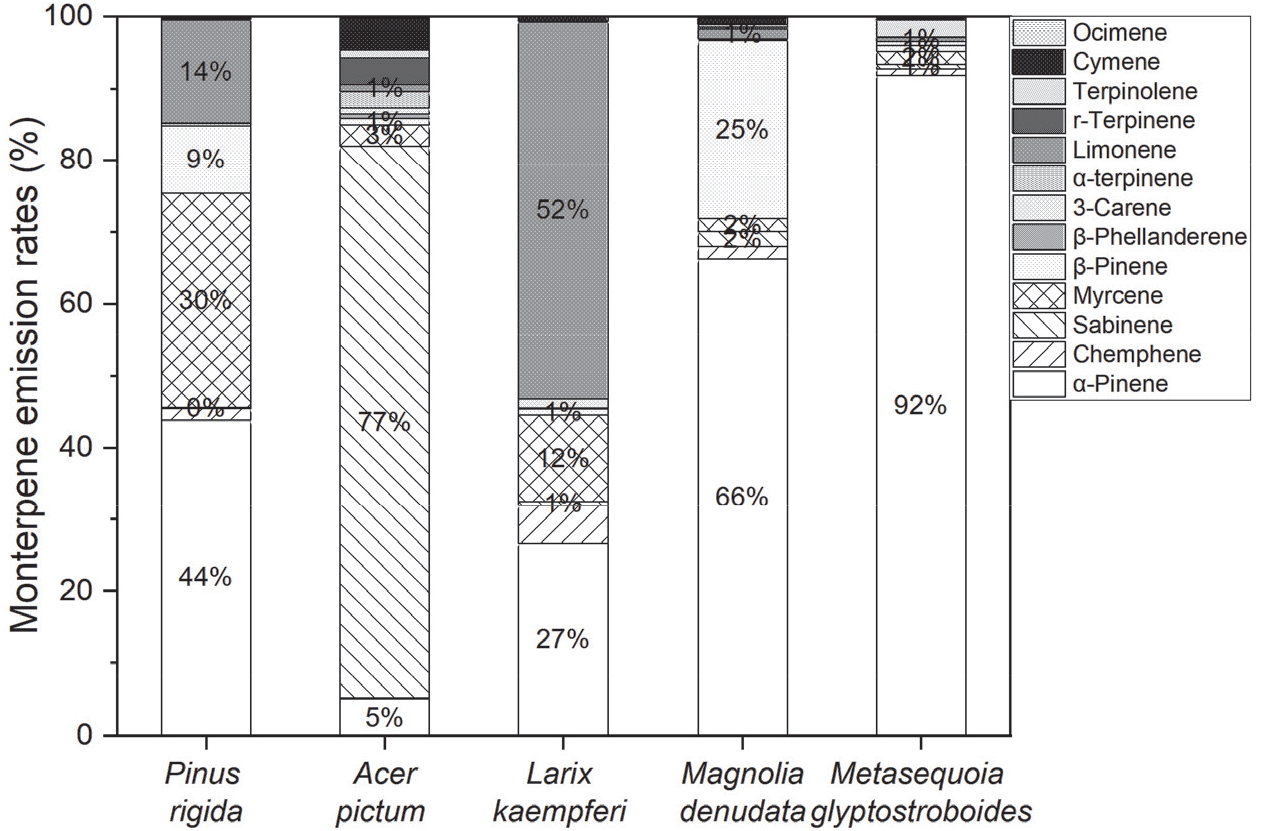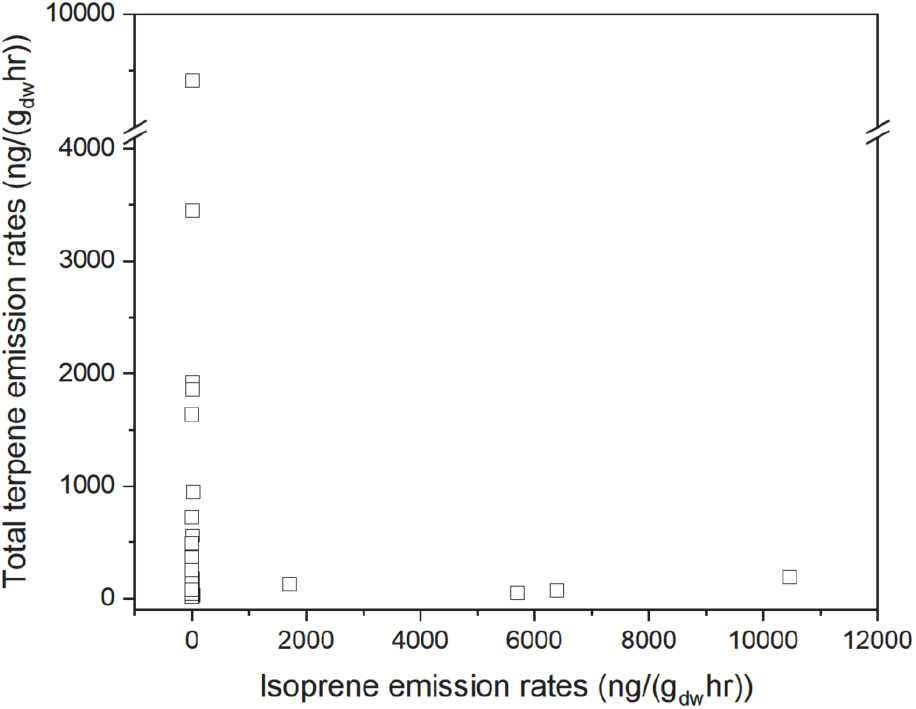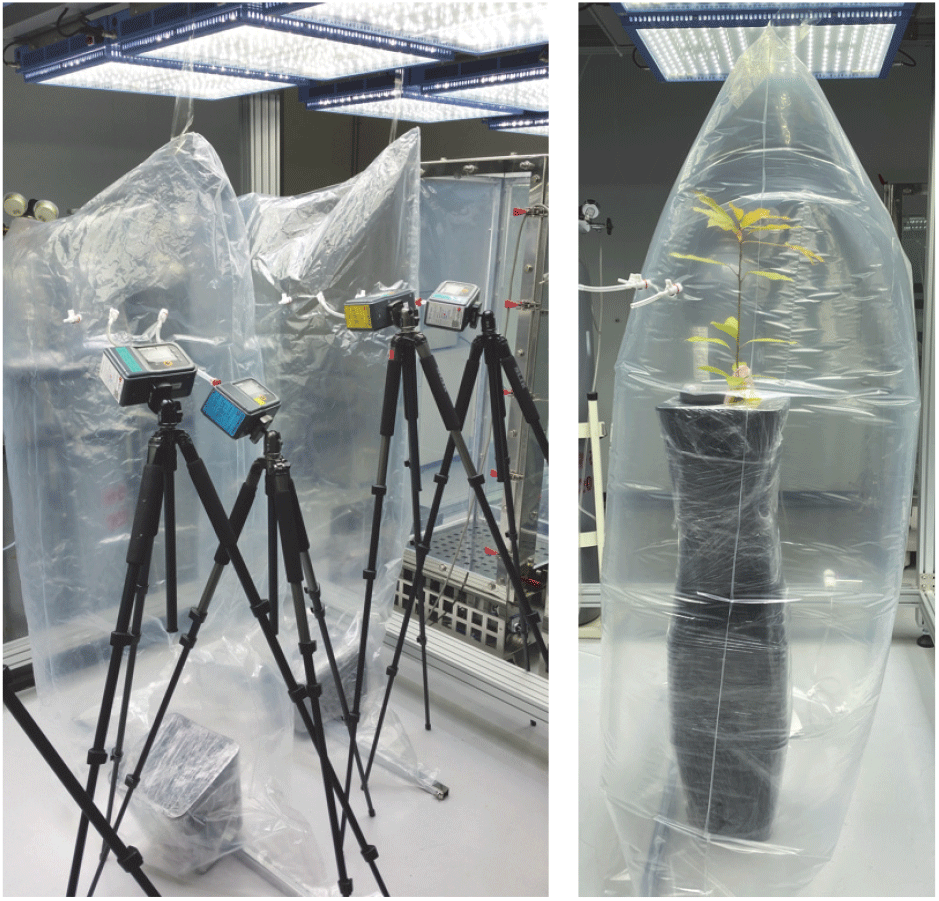서 론
최근 사용되고 있는 숲세권이라는 용어는 주거공간으로부터 가까운 거리에 이용 가능한 녹지공간 또는 도시숲이 존재한다는 의미를 포함하고 있다. 이처럼 숲세권 용어가 일반적으로 사용될 만큼 숲의 실질적 사회, 경제적 효과에 대한 인식이 확대되면서 스트레스 해소, 건강증진 등 도시민의 삶의 질 개선을 위한 생활권 산림 복지서비스에 대한 요구가 증가하고 있다. 이에 따라 미세먼지, 도시열섬현상 등을 조기에 분산, 저감을 위해 도시 외곽의 찬바람을 끌어들여 대기 정체를 해소하는 바람길 숲 조성, 미세먼지 발생원 및 도로주변의 미세먼지 흡착, 흡수, 차단할 수 있는 미세먼지 저감숲 조성, 지진, 산사태, 폭염 등 재해 발생 시 시민들의 대피소 기능을 할 수 있는 개방형 숲 조성 목적을 우선 적용하여 도시숲의 다원적 효과를 고려하여 수종 선택, 배치 등 설계 및 조성에 대한 관심이 지속적으로 증가하고 있다.
2019년 우리나라의 생활권 도시림은 54,354 ha로 도시면적의 2.0%, 국토면적의 약 0.6%에 불과하며 도시 인구 1인당 생활권도시림 면적은(Statistics Korea) 2011년 7.95 m2/인, 2015년 9.91 m2/인, 2017년 10.07 m2/인, 2019년 11.51 m2/인으로 증가하고 있으나 주요 선진도시와 도시생활환경을 개선하고 국민수요에 부응하기에는 아직 부족한 실정이다.
또한 휴식과 건강을 위한 장소로써 숲에 대한 관심이 높아짐에 따라 숲은 치유의 공간으로써 인식되고 있으며 2019년을 기준으로 치유의 숲 운영개소는 28개소, 방문자수 1,861,226명, 프로그램 이용자수 320,810명으로 2015년부터 통계작업을 시작한 이후로 꾸준한 증가를 나타내고 있다(Statistical Yearbook of Forestry, 2020). 따라서 숲의 여러 가지 치유인자들 중에서 수목에서 방산되는 휘발성물질인 피톤치드(phytoncide)에 대한 관심이 높아지고 있다.
휘발성유기화합물(Volatile Organic Compounds, VOCs)은 상온 및 상압에서 대기 중으로 가스형태로 쉽게 휘발되는 탄화수소화합물이며 VOCs는 인위적인 발생원에서 방출되는 인위기원 VOCs(Anthropogenic VOCs, AVOCs)와 자연 발생원에서 방출되는 자연기원 VOCs(Natural VOCs, NVOCs)로 구분할 수 있다. NVOCs 중 식물체에서 isoprene, monoterpene, sesquiterpene과 같은 화합물들 형태로 방출되는 피톤치드를 포함한 VOCs를 총칭하여 생물유래 휘발성유기합물 BVOCs(Biogenic Volatile Organic Compounds)로 구분하고 있다(Park et al., 2021). 이러한 BVOCs에 포함되어 있는 피톤치드는 삼림욕 물질로써 인체의 항산화 지수변화(Min and Kim, 2019), 아토피 피부염 완화 효과(Lee et al., 2010), 스트레스 점수 감소(Choi et al., 2016), 교감신경계 및 부교감신경계 활성도 변화에 대한 연구결과(Kim et al., 2012)가 보고되었다.
한편, 대기화학적 관점에서 보면 BVOCs는 높은 반응성으로 질소산화물(NOx)과 광화학반응을 하여 오존을 생성하는 것으로 보고되고 있다. 또한 이차유기에어로졸의 생성(SOA; Secondary Organic Aerosol), 탄소순환의 수지 균형, 산성 침적과 산성비 생성에 기여하는 유기산의 생성 등에도 주요한 영향을 미치는 것으로 보고되고 있다(Wu et al., 2020; Ding et al., 2014; Bonn et al., 2017).
따라서 식생에서 방출되는 BVOCs 방출량에 대한 연구로 monoterpene의 방출량은 온도 의존성이 높은 것으로 보고되었고(Dominguez-Taylor, 2007), isoprene 방출은 온도와 광합성유효복사량(Photosynthetically Active Radiation; PAR) 변화에 따라 영향을 받는 것으로 보고되었다(Harrison et al., 2001; Xiaoshan et al., 2000).
국내에서도 챔버를 이용하여 산림 현지나 실험실에서 온도와 빛, PAR 환경에 따라 우리나라 대표 수종인 소나무(Pinus densiflora), 전나무(Abies holophylla), 잣나무(Pinus koraiensis)를 포함하여 곰솔(Pinus thunbergii)과 구상나무(Abies koreana), 삼나무(Cryptomeria japonica), 편백(Chamaecyparis obtusa), 은행나무(Ginkgobiloba), 벚나무(Prunus serrulata), 느티나무(Zelkova serrate), 신갈나무(Quercusmongolica)의 BVOCs 방출량에 대한 연구가 진행되었다(Lim et al., 2008; Kim et al., 2005; Kim et al., 2004; Park et al., 2021).
전 세계적으로 2000년에 방출된 BVOCs의 총량은 약 1 Pg (1015 g)으로 BVOCs 중에는 isoprene 53%, monoterpene 16%와 기타 반응성 VOCs 31%으로 이루어져 있으며 그 방출량은 AVOCs보다 약 10배 정도 많은 것으로 추정된다(Guenther et al., 1995, 2012; Simpson et al., 1999).
국내에서 BVOCs의 방출량은 총 431,000톤/년으로 AVOCs의 방출량(723,000톤/년)의 약 60% 정도가 방출되는 것으로 추정하고 있다(Lee et al., 2014). 2020년 한국임업통계연보(Statistical Yearbook of Forestry, 2020)에 따르면 우리나라 산림면적은 2019년 6,299,276 ha로 전체면적의 약 62.7%가 산림지역인 상황이지만 자연 발생원에 의한 VOCs 방출에 대한 정보는 미흡하다. 또한 국내의 방출량 산정작업에서는 미국 EPA에서 제공하는 방출계수를 적용하고 있다. 따라서 우리나라의 실제적인 생육환경이 반영된 방출계수가 아닌 외국의 자료들을 적용하여 BVOCs 방출을 산정함으로 인해 우리의 현실을 반영한 평가를 하는데 한계가 있다(Lee et al., 2014). 그러므로 피톤치드의 대표적인 물질인 terpene과 isoprene를 포함한 BVOCs 방출 농도를 정확하게 파악하기 위해서는 지역에 분포하고 있는 식생종류별로 방출량 및 엽량 등에 대한 정확한 자료를 얻는 것이 필요하다. 특히 국내 주요 조림수종 및 조경수·가로수종에 대한 BVOCs 방출계수 DB 구축은 매우 미흡한 상황이다. 이에 본 연구에서는 우리나라 도시숲 주요 수종에서 방출되는 isoprene 및 terpene류의 표준 방출량 및 성분에 대한 DB를 구축하여 도시숲 조성 수종의 선정 기준을 마련하여 향후 수도권의 도시숲 또는 녹지 형성 시 산림 치유와 대기환경의 질을 높일 수 있는 적절한 수종선택의 가이드라인 제시에 활용하고자 한다.
재료 및 방법
국내 주요 조경 및 조림 수종, 지피식물 중에서 식재 본수, 수목 형태(상록, 낙엽) 및 크기(교목, 관목)와 도시 숲 내 중요성, 보편성, 수급용이성 등을 고려하여 도시숲 주요 30 수종을 선정하였으며 3년생 이하 묘목을 연구 대상으로 하였다(Table 1). 묘목은 침엽수/활엽수용 상토를 넣고 화분(25 cm×25 cm×25 cm)에 식재하였다. BVOCs 측정 2일 전 묘목에 동일한 양의 관수를 한 후 표준환경조건(온도: 30℃, 광도: 1,000 μmol/m2/sec)으로 유지되는 챔버에 넣고 순화시켰다.
묘목에서 방출되는 BVOCs 시료를 채취하기 위해서 챔버 내부가 표준환경조건이 유지되고, 화분을 포함하여 묘목 전체를 챔버 안에 넣을 수 있도록 1 m×2 m, 400 L Tedlar bag를 제작하여 고순도 Air를 사용하는 순환형 챔버(dynamic flow through chamber)를 시스템을 구축하였다(Figure 1).
챔버의 배경농도는 고순도 Air를 300 L 채운 후, 밀폐하여 표준환경조건에서 30분간 노출 시킨 후 챔버 내부의 공기를 채취하여 분석하였다. 배경농도를 측정 후 챔버 내부의 고순도 air를 모두 제거하고 해당 묘목과 온·습도계를 설치하고 표준환경조건에서 고순도 Air 유량을 약 3~4 L/min로 주입하여 배출구에서 약 2~2.5 L/min 유량이 유지된 후 60분 동안 유지시켰다.
본 연구에서 분석대상 BVOCs 물질은 isoprene (ISO)과 terpene류로 구분하였고 terpene 물질은 기존 연구논문을 참고하여(Ortega and Helmig 2008; Yaman et al., 2015; Chen et al., 2020) monoterpene (MT) 13종류, oxygenated monoterpenes (OMT) 13종류, sesquiterpenes (ST) 5종류, oxygenated sesquiterpenes (OST) 6종류로 구분하여 총 38개 BVOCs 성분을 분석하였다(Table 2).
Isoprene과 terpene의 검정곡선을 위한 표준흡착관 제작과 정량 분석 방법은 실내공기질공정시험기준의 실내 및 건축자재에서 방출되는 휘발성유기화합물 측정 방법-고체흡착관과 기체크로마토그래프-MS/FID법(ES 02602.1c)을 이용하였다. 휘발성분 포집에 사용된 Tenax TA 흡착관(Supelco, USA)은 사용 전 흡착관 컨디셔너(APK1200, KNR, Korea)를 이용하여 300℃에서 4시간 컨디셔닝 실시 후 사용 하였다. Isoprene 표준물질(59240-1ML-F, Sugma-Aldrich), terpene 표준물질(CAN-Terp-Mix1&2, SPEX Certiprep, USA)을 사용한 흡착관 제조는 표준물질 흡착장치(CT1100, CHEMTEKINS, Korea)를 이용하여 200℃에서 고순도 He gas 100 mL/min 유속인 상태로 액체 표준물질이 기화될 수 있는 조건에서 농도별로 제조하였다. Isoprene 표준물질, terpene 표준물질과 챔버에서 기체시료를 포집한 흡착관은 열탈착(ATD)-GC/MS (Tubomatrix350-Clarus 680/Clarus SQ8T, Perkin Elmer, USA)를 이용하여 Table 3과 4의 분석조건과 selected ion monitoring (SIM) mode로 분석하였다.
수종별 isoprene과 terpene 시료 채취는 동일수종 3개체를 개별 챔버를 사용하여 동시에 표준환경조건에서 노출시킨 후 각각의 챔버에서 Tenax TA 흡착관과 시료채취펌프(MP-Σ30, SIBATA, Japan) 사용하여 100 mL/min의 유속으로 10분동안 1 L 포집하였다. 모든 수종의 BVOCs 시료는 2020년 8월~9월, 오전 11:00~14:00에 포집하였다.
수종별 표준환경조건에서의 BVOCs 방출량(ER: emission rate)은 Ortega and Helmig(2008)가 보고한 식을 사용하여 실측한 수종별 BVOCs 농도와 챔버 배경농도, 챔버에서 배출되는 공기유량과 잎 건중량을 고려하여 다음의 식으로 건중량당 BVOCs 방출량을 계산하였다. 잎은 65°C에서 향량이 될 때까지 건조시킨 후 건중량을 측정하였다(Table 1).
ERBVOCs : BVOCs 방출량 ng/(gdw·hr)
Q : 챔버 배출 유속 (m3/hr)
Csample chamber : 챔버 내부의 수종별 BVOCs 농도(ng/m3)
Cempty chamber : 챔버 배경 농도
gdw : BVOCs 시료 채취 후 수종별 잎의 건중량(g)
결과 및 고찰
공시수종을 표준환경조건에서 건중량 당 isoprene, monoterpenes, oxygenated monoterpenes, sesquiterpenes, oxygenated sesquiterpenes 방출량 측정결과를 Table 5에 나타 냈다. 수종별 방출량은 왕대(Phyllostachys bambusoides)에서 10,458±2,328 ng/(gdw·hr)으로 가장 높게 나타났다. 다음으로 졸참나무(Quercus serrata) 6,386±1,616 ng/(gdw·hr), 굴거리나무(Daphniphyllum macropodum) 5,693±1,012 ng/(gdw·hr), 회양목(Buxus Koreana) 1,711±348 ng/(gdw·hr) 순으로 나타났으며 그 외 수종에서는 15.5~0.6 ng/(gdw·h)으로 상대적으로 낮은 방출량을 나타냈다. 또한 isoprene 방출량이 높은 왕대, 졸참나무, 굴거리나무, 회양목에서는 teperene 성분의 방출량이 매우 낮게 나타났다. 따라서 측정한 30 수종 중에서 주요 isoprene 방출 수종으로 분류되었다.
Isoprene은 주로 활엽 수종에서 방출되며 활엽수는 BVOCs를 저장하지 않고 바로 광합성 작용을 통해 BVOCs를 방출하는 특성이 있으며(Kim et al., 2015), 온도와 PAR 변화에 따라 영향을 받는 것으로 보고되고 있다(Harrison et al., 2001; Xiaoshan et al., 2000). 본 연구에서는 대나무류에 속하는 왕대에서 가장 높은 isoprene 농도를 나타냈으며 이와 유사한 결과로 Chang et al.(2019)에서 12수종의 moso bamboo 잎의 isoprene 방출 플럭스 측정결과 검출된 6개 수종에서는 잎의 온도와 광량에 따라 isoprene 방출량이 증가하는 것으로 보고되었다.
국내에서는 대표적인 참나무 수종인 졸참나무(Quercus serrata), 갈참나무(Quercus aliena), 상수리나무(Quercus acutissima), 굴참나무(Quercus variabilis)에 대해 지리산과 금성산에서 cuvette 측정 결과, 졸참나무와 갈참나무의 isoprene 방출량이 높은 것으로 보고되었다(Kim et al., 2004). 제주지역 졸참나무, 상수리나무, 물참나무(Quercus crispula) BVOCs 방출특성에서도 졸참나무의 isoprene 방출량이 가장 높게 나타났다(Kim and Lee, 2012).
본연구와 기존 연구에서 동일 속인 굴참나무, 졸참나무, 갈참나무, 물참나무, 상수리나무 중에서는 졸참나무의 isoprene 방출량이 가장 크게 나타났다. 이와같이 동일 속일지라도 종에 따라서 방출량이 차이가 나타났다. 기존 연구에서는 이러한 결과는 토양이나 기후 등 수목의 서식환경에 따라 방출량서 차이를 보이는 것으로 추정되는 것으로 보고하였지만 본 연구에서는 동일한 서식환경과 수령 고려한다면 종에 따른 방출특성으로 판단되었다.
Owen et al.(2001)은 portable dynamic teflon branch enclosure를 이용하여 회양목(Buxus sempervirens)에서 10.0 ng/(gdw·hr)의 isoprene 방출량 결과를 보고하였다.
도심에 많이 식재되어있는 왕벚나무(Prunus x yedoensis)의 isoprene 방출량은 1.6 ng/(gdw·hr)으로 매우 낮게 나타났고 이와 같은 결과는 Sun and Leu(2004)의 연구에서 왕벚나무는 다른 수종과 비교하여 상대적으로 매우 낮은 isoprene 방출량을 나타낸 것으로 보고한 연구와 유사한 결과를 나타냈다.
Monoterpene은 주로 침엽수에서 방출되는 것으로 알려져 있으며 침엽수는 활엽수와는 달리 광합성을 하면 바로 방출되지 않고 잎에 저장되어 있다가 늦은 오후부터 방출되어 밤 동안에도 방출되는 특성이 있다(Laffineur et al., 2011). Monoterpenes 방출량을 분석한 결과(Table 5) 리기다소나무(Pinus rigida)에서 9,154±2,328 ng/(gdw·hr)으로 가장 높게 나타났다. 고로쇠(Acer pictum) 3,282±125 ng/(gdw·hr), 일본잎갈나무(Larix kaempferi) 1,828±93 ng/(gdw·hr), 백목련(Magnolia denudata) 1,794±129 ng/(gdw·hr), 메타세쿼이아(Metasequoia glyptostroboides) 1,547±62 ng/(gdw·hr), 잣나무(Pinus koraiensis) 937±90 ng/(gdw·hr), 소나무(Pinus densiflora) 725±50 ng/(gdw·hr), 전나무(Abies holophylla) 343±19 ng/(gdw·hr) 순으로 나타났다. 또한 monoterpenes의 방출량이 높은 수종들은 isoprene의 방출량이 매우 낮게 나타나서 monoterpene 주요 방출 수종으로 구분할 수 있었다. 침엽수종뿐 아니라 고로쇠나무 및 백목련 등과 같이 일부 활엽수종도 monoterpene을 주로 방출하는 것으로 나타났으며, 이처럼 유럽너도밤나무(Fagus sylvatica L.), 호랑잎가시나무(Quercus ilex L.) 등 일부 활엽수종에서도 monoterpene 주요 방출 수종으로 알려져 있다(Schurgers et al., 2009).
Figure 2에는 주요 monoterpene 방출 수종의 개별물질별 방출비율을 나타냈다. 리기다소나무에서는 α-pinene의 방출량은 4,015 ng/(gdw·hr)로 가장 높은 44%에 해당했으며 myrcene 30%, 2,726 ng/(gdw·hr), limonene 14%, 1,317 ng/(gdw·hr), β-pinen 9%, 857 ng/(gdw·hr) 순으로 나타났다. 지리산 소나무의 잎과 가지를 80 L 챔버로 밀폐시켜 3월부터 11월까지 monoterpene 방출을 분석한 연구에서는 α-pinene, myrcene, β-phellandrene, β-pinene이 주요 물질이며 limonene의 경우에는 계절에 따라 편차가 있은 것으로 보고하였고(Park et al., 2021), 본 측정결과와 유사한 결과를 나타냈다.

한편 고로쇠나무는 isoprene보다 monoterpene의 방출량이 더 높았으며 sabinene의 방출랑이 2,521 ng/(gdw·hr)로 전체 monoterpene 방출량 중에서 약 77%에 해당되었다. 이와 같은 결과는 제주지역 수종별 연간 BVOC 방출량을 산정한 결과 고로쇠나무는 isoprene의 방출량(0.057 ton/year) 보다 monoterpene 방출량(5.015 ton/year)이 더 높은 것으로 보고한 Kim(2013)의 결과와 유사한 경향을 나타냈다.
일본잎갈나무에서는 limonene 52%, 958 ng/(gdw·hr), α-pinene 27%, 486 ng/(gdw·hr), myrencne 12%, 2,726 ng/(gdw·hr) 순으로 나타났다.
Conifer cuvette을 이용해서 일본잎갈나무 잎에서 방출되는 monoterpene을 분석한 결과(Mochizuki et al., 2017)에서는 α-pinene, β-pinene, myrcene, β-phellandrene, limonene을 주요 물질로 보고하여 본 연구와 유사한 결과를 나타냈다. Mochizuki et al.(2014)의 연구에서는 terpenoid flux를 이용하여 일본잎갈나무림에서 BVOC를 1년 동안 장기 측정한 결과 주요 방출 물질은 α-pinene, β-pinene, sabinene, myrcene, camphene으로 보고하였다. 동일한 방법으로 일본잎갈나무림에서 가을철에 BVOCs 방출량을 측정한 결과에서도 α-pinene을 주요 물질로 보고하였다(Ieda et al., 2006).
동일 수종의 경우에도 수령, 생육환경, 측정조건 등에 따라 주요 방출 BVOCs종 및 그 방출량이 다르게 나타나는 것으로 판단되었다. 뿐만 아니라 수목에서 직접 방출되는 BVOCs와 산림대기 중의 BVOCs가 다르게 나타날 수 있었다. 이는 BVOCs가 대기중의 OH, O3, NO3와 반응하는 lifetime과 관련이 있다. 대기중의 OH, O3, NO3와 α-pinene의 반응속도는 각각 2.6 h, 4.6 h, 11 min 이였지만 limonene은 49 min, 2.0 h, 5 min으로 상대적으로 빠르게 대기 중의 OH, O3, NO3와 반응하는 것으로 보고되었다(Atkinson, 2000; Atkinson and Janet, 2003). 따라서 챔버를 이용한 수목의 잎과 가지에서는 방출되는 limonene은 챔버 내부에 남아 있지만 산림 대기중에서는 OH, O3, NO3와 반응하여 농도가 낮게 나타난 것으로 판단되었다.
Monoterpenes 방출량이 높은 수종 중에서 백목련은 α-pinene 1189 ng/(gdw·hr), β-pinene 447 ng/(gdw·hr)이 주요 물질이였다. Liang et al.(2010)은 백목련의 BVOCs 측정결과 terpene 함량은 전체중에서 72%로 가장 높았다고 보고했다. 메타세쿼이아는 α-pinene 1420 ng/(gdw·hr)이 주요 물질로 나타났다. Matsunaga et al.(2017)은 5 L bag를 이용하여 가지 끝부분을 밀폐시켜서 측정한 결과 메타세쿼이아의 주요 방출 성분을 α-pinene, β-caryophyllene으로 보고하였다. 본 연구에서도 메타세쿼이아는 전체 monoterpenes 방출량 중에서 α-pinene이 92%를 차지하였으며 β-caryophyllene은 sesquiterpene류 방출항목에 검출되어 유사한 경향을 나타냈다.
총 oxygenated monoterpenes의 방출량은(Table 5) 섬잣나무, 리기다소나무, 고로쇠나무, 중국단풍, 조팝나무에서 199~113 ng/(gdw·hr)이었으며 그 외 수종에서는 91~2.6 ng/(gdw·hr) 범위를 나타냈다. 개별 oxygenated monoterpene 물질 중에서 섬잣나무 pulegone, borneol, menthol, 리기다소나무는 eucalyptol, 고로쇠나무 pulegone, 중국단풍 menthol, 조팝나무 nerol이 주요 성분으로 나타났다.
Sesquiterpenes의 방출량은(Table 5) 리기다소나무가 70 ng/(gdw·hr)으로 가장 높게 나타났으며 개별 물질로는 caryophyllene, farnesene이 주요 물질이었다.
총 oxygenated sesquiterpenes의 방출량은 단풍나무 167 ng/(gdw·hr), 왕대 115 ng/(gdw·hr) 순으로 나타났으며 두 수종 모두 주요 물질은 carypphyllene oxide 였다. 그 외 수종에서의 총 oxygenated monoterpenes의 방출 속도는 65~0.4 ng/(gdw·hr) 범위로 나타냈다.
Monoterpenes, oxygenated monoterpenes, sesquiterpenes, oxygenated sesquiterpenes 방출량을 모두 합하여 총 terpene과 isoprene 방출량 상관관계를 Figrue 3에 나타냈다.

수종별 BVOCs 방출특성 비교하면 terpene과 isoprene을 일정 수준 이상 동시에 방출하는 수종은 없었으며, terpene 물질 방출수종, isoprene 방출수종, BVOCs 저방출 수종으로 구분할 수 있었다. Isoprene 주요 방출 수종은 30개 수종 중에서 왕대, 졸참나무, 굴거리나무, 회양목으로 나타났다. Terpene 주요 방출 수종은 총 방출량을 기준으로 총 5단계로 100 ng/(gdw·hr) 미만 10수종, 100 이상 500 ng/(gdw·hr) 미만 12수종, 500이상 1,000 ng/(gdw·hr) 미만 3수종, 1,000이상 5,000 ng/(gdw·hr) 미만 4수종, 5,000 ng/(gdw·hr) 이상 1수종으로 구분 할 수 있었으며(Table 6) 추후에 추가되는 수종에 대한 결과를 반영할 예정이다.
결 론
본 연구에서는 우리나라 도시숲에 분포하는 주요 30 수종을 선정하여 표준환경조건(온도: 30℃, 광도: 1,000 μmol/m2/sec)에서 순환형 챔버를 이용하여 수종별 isoprene 및 terpene류의 수종별 방출량을 분석하였다.
Isoprene 방출량을 분석한 결과 왕대에서 가장 높게 나타났으며 졸참나무, 굴거리나무, 회양목 순으로 나타났으며 그 외 수종에서는 상대적으로 매우 낮은 방출량을 나타냈다. Monoterpenes 방출량은 리기다소나무가 가장 높았고, 고로쇠나무, 일본잎갈나무, 백목련, 메타세쿼이아, 잣나무, 소나무, 전나무 순으로 나타났으며 총 oxygenated monoterpenes의 방출량은 섬잣나무, 리기다소나무, 고로쇠나무, 중국단풍, 조팝나무 순으로 나타났다. Sesquiterpenes의 방출량은 리기다소나무에서 가장 높았고, 총 oxygenated sesquiterpenes의 방출량은 단풍나무, 왕대 순으로 나타났다. 본 연구 결과를 기준으로 하여 향후 더 많은 도시숲 수종을 대상으로 isoprene 주요 방출 수종과 5구간으로 분류된 terpene 주요 방출 수종의 데이터베이스 구축을 진행할 예정이다. 본 연구에서 제시된 도시숲 주요 수종의 BVOCs 방출 특성은 국내 최초로 많은 수종을 대상으로 DB를 구축했다는 점에서 큰 의의가 있으며, 이와 더불어 수종별 생태적, 심미적, 환경내성적 특성을 고려하여 도시숲 조성을 위한 수종 선정 가이드라인을 제시할 수 있을 것으로 기대된다.
